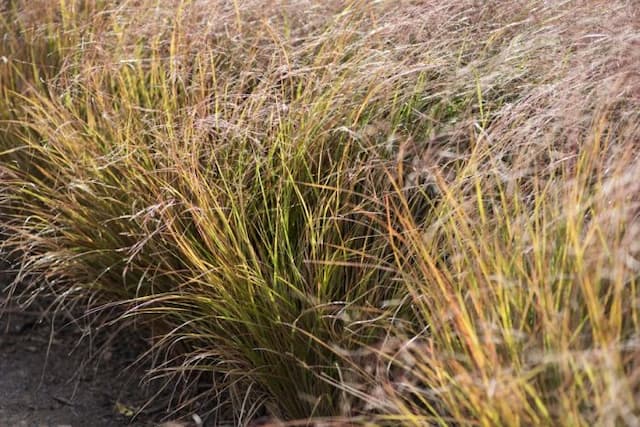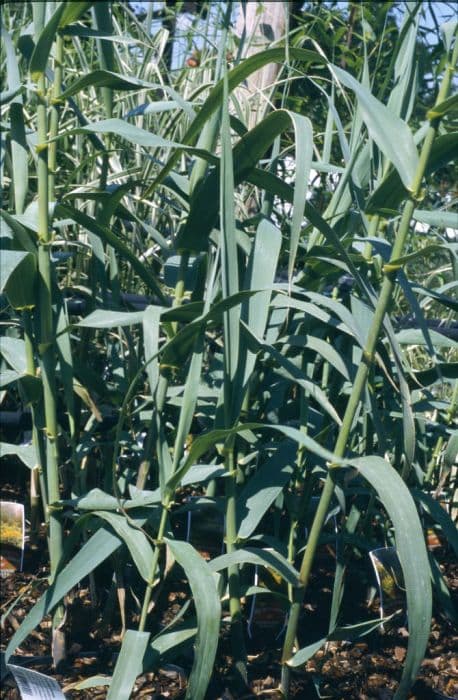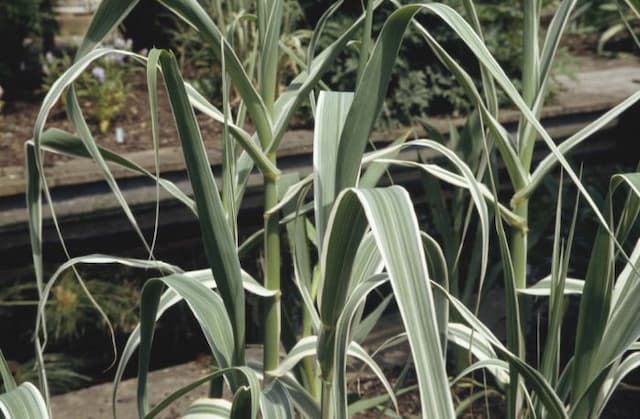Maiden Grass Miscanthus sinensis 'Morning Light' (v)











ABOUT
Miscanthus sinensis 'Morning Light' is commonly known as Morning Light Silver Grass. As the name suggests, this ornamental grass has a light, airy quality to it. One of its distinctive features is the variegation in its foliage. Each slender leaf displays a narrow strip of white along the edges, which gives the whole plant a silvery appearance when viewed from a distance. During the growing season, the leaves are predominantly green with a graceful, arching habit. This variegation creates a shimmering effect in the sunlight, as if each blade of grass is outlined with a thin thread of light—a characteristic that surely inspired the cultivar's name. As the seasons change, Morning Light Silver Grass undergoes a transformation in color. The foliage takes on a warm, golden hue in autumn, providing a beautiful display of fall colors. In addition to its lovely leaves, the plant produces feathery flower plumes in late summer or early fall. The plumes start out with a pinkish or reddish tint before fading to a soft, silvery white. These delicate flowers add a textural contrast to the narrow leaves, rising above the foliage like a soft mist or morning fog. Overall, the appearance of Morning Light Silver Grass is one of elegance and grace. Its fine-textured foliage sways in the breeze, making it a dynamic and visually captivating plant in the landscape. Its ability to catch the light and its seasonal color changes make it a favorite among gardeners looking for year-round interest.
About this plant
 Names
NamesFamily
Poaceae.
Synonyms
Morning Light Silver Grass, Morning Light Maiden Grass, Variegated Maiden Grass, Morning Light Eulalia Grass, Morning Light Japanese Silver Grass.
Common names
Miscanthus sinensis 'Morning Light'
 Toxicity
ToxicityTo humans
Maiden grass is not known for being toxic to humans. However, as with many plants, it can potentially cause irritation if a person has specific allergies or sensitivities. There are no common symptoms of poisoning, as it's not considered poisonous.
To pets
Maiden grass is also not known for being toxic to pets. It does not typically pose a risk for poisoning if pets ingest parts of this plant. However, always be cautious as individual animals might have unique sensitivities or reactions.
 Characteristics
CharacteristicsLife cycle
Perennials
Foliage type
Deciduous
Color of leaves
Variegated
Flower color
Pink
Height
4-6 feet (1.2-1.8 meters)
Spread
2-3 feet (0.6-0.9 meters)
Plant type
Grass
Hardiness zones
5
Native area
Asia
Benefits
 General Benefits
General Benefits- Ornamental Value: Adds aesthetic appeal to gardens with fine-textured variegated foliage and graceful form.
- Low Maintenance: Requires minimal care once established, tolerating a wide range of soil conditions.
- Drought Resistance: Can survive with limited water supply, making it suitable for xeriscaping.
- Year-Round Interest: Provides visual interest throughout the seasons, with green and white foliage in spring and summer, and tan to bronze plumes in fall and winter.
- Erosion Control: Its dense root system helps stabilize the soil and prevent erosion on slopes.
- Pest and Disease Resistance: Generally resistant to common pests and diseases, reducing the need for chemical treatments.
- Wildlife Habitat: Offers shelter and nesting materials for birds and can be a food source for deer and other wildlife.
- Privacy Screen: Can be used as a natural screen or hedge to create privacy in the landscape.
 Medical Properties
Medical PropertiesThis plant is not used for medical purposes.
 Air-purifying Qualities
Air-purifying QualitiesThis plant is not specifically known for air purifying qualities.
 Other Uses
Other Uses- As a privacy screen or living fence: Miscanthus sinensis 'Morning Light' can be used to create dense, tall barriers for privacy in gardens and residential areas due to its lush foliage.
- Erosion control: With its robust root system, this grass helps to stabilize soil and prevent erosion on slopes and banks.
- Sound insulation: Planted in mass, it can help reduce noise pollution from roads and industrial areas.
- As a winter interest plant: The dried foliage and plumes of 'Morning Light' provide aesthetic interest during the winter months when most plants are dormant.
- Biodegradable mulch: Once cut, the dry leaves and stems can be used as organic mulch around garden beds to suppress weeds and retain soil moisture.
- Ornamental fish ponds and water features: 'Morning Light' can be planted around ponds to provide habitat for wildlife and add vertical interest.
- As a natural windbreak: The dense growth of this plant can be used to protect smaller plants from strong winds in a landscape setting.
- Thatching: The dried stems of Miscanthus sinensis 'Morning Light' can be used in crafting traditional thatched roofs or panels.
- Photography and art: The delicate structure of the 'Morning Light' seed heads is prized by photographers and artists for its beauty and complexity.
- Craft material: Dried stems and flower plumes can be used in floral arrangements, wreaths, and other decorative craft projects.
Interesting Facts
 Feng Shui
Feng ShuiThe Maiden Grass is not used in Feng Shui practice.
 Zodiac Sign Compitability
Zodiac Sign CompitabilityThe Maiden Grass is not used in astrology practice.
 Plant Symbolism
Plant Symbolism- Beauty in Simplicity: The 'Morning Light' miscanthus, with its slender leaves and fine texture, symbolizes the beauty that can be found in simple, understated forms. It serves as a reminder that not all that is beautiful is complex or bold.
- Adaptability: Miscanthus sinensis thrives in a variety of conditions, representing the ability to adapt and prosper in different environments. It symbolizes resilience and flexibility.
- Privacy: The tall growth habit of the miscanthus makes it an excellent plant for creating natural privacy screens in gardens, symbolizing the need for personal space and boundaries.
- Graceful Aging: As the plant transitions from green to golden brown in the fall and remains attractive even in winter, it symbolizes the grace and beauty that can come with aging and the passage of time.
- Balance: The narrow and upright growth of 'Morning Light' grass, along with its variegated foliage, represents balance and harmony. Its symmetrical form can symbolize the idea of equilibrium in life.
 Water
WaterMaiden grass (Miscanthus sinensis 'Morning Light') prefers consistent moisture, especially during its growing season in spring and summer. Water the plant deeply to ensure the soil is moist but not waterlogged, which roughly translates to about 1 inch of water per week. During hot spells or extended periods of drought, increase watering to twice a week, providing about 1 to 1.5 gallons each time, depending on the size of the plant and soil conditions. Reduce watering in the fall as the plant begins to go dormant and cease watering in winter. Always check the top few inches of soil for dryness before watering to prevent overwatering.
 Light
LightMaiden grass thrives in full sunlight and should be planted in a spot where it can receive at least 6 hours of direct sunlight daily. It can tolerate partial shade but its growth may not be as vigorous or upright. The ideal location for maiden grass is an open area where it's exposed to the full sun for the majority of the day to promote the best foliage colors and plume production.
 Temperature
TemperatureMaiden grass is hardy in USDA zones 5 through 9, withstanding temperatures as low as -20°F to -10°F in the winter. The ideal temperature for growing maiden grass ranges from 75°F to 85°F, which promotes active growth. It can tolerate high summer temperatures well into the 90s°F as long as it is adequately watered.
 Pruning
PruningPruning maiden grass is essential for maintaining its shape and encouraging new growth in the spring. Cut back the entire plant to about 4 to 6 inches from the ground in late winter or early spring before new growth begins. This timing allows the plant to focus its energy on producing fresh, healthy shoots. Pruning annually will keep the plant looking tidy and prevent it from becoming too dense, which can lead to issues with airflow and pests.
 Cleaning
CleaningAs needed
 Soil
SoilMaiden Grass thrives in well-drained soil with a pH of 5.5 to 7.0. A good mix is loamy soil with compost and peat for moisture retention and fertility.
 Repotting
RepottingMaiden Grass typically does not require frequent repotting as it is commonly planted directly in the ground outside and can spread through its rhizome system.
 Humidity & Misting
Humidity & MistingMaiden Grass is adaptable to a wide range of humidity levels and does not require specific humidity conditions to thrive.
 Suitable locations
Suitable locationsIndoor
Place in bright light, keep it dry, avoid overcrowded pots.
Outdoor
Full sun, well-drained soil; space to accommodate growth.
Hardiness zone
4-9 USDA
 Life cycle
Life cycle'Morning Light' is a variegated cultivar of Miscanthus sinensis, commonly known as Japanese Silver Grass or Maiden Grass. The lifecycle begins with seed germination in suitable warm conditions, although this cultivar is often propagated by division. Following germination, the grass enters a phase of vegetative growth, developing long, narrow foliage with white variegation and forming dense clumps. During late summer to fall, it transitions to reproductive maturity, sending up tall flower plumes that can reach several feet above the foliage, which later produce viable seeds if conditions permit. Throughout winter, the plant goes dormant, with the foliage browning, but providing visual interest and habitat in the garden. As spring arrives, the grass can be cut back to encourage fresh, new growth, completing its annual cycle.
 Propogation
PropogationPropogation time
Spring to early summer
Propogation: The most popular method for propagating Miscanthus sinensis 'Morning Light', commonly known as Maiden Grass, is by division. This occurs in the late spring once the ground has thawed or in the early fall, avoiding the heat of the summer which can stress the young plants. To propagate by division, carefully dig up an established clump of Maiden Grass, ensuring to get as much of the root system as possible. Using a sharp spade or knife, divide the root mass into sections, each with several shoots and a healthy portion of roots. These divisions should then be replanted at the same soil depth they were originally growing at, spaced out adequately to allow for future growth. It is key to keep the newly planted divisions well-watered until they are established, which typically takes a few weeks. Through division, gardeners can efficiently produce new plants that will be true to the parent in form and characteristics.









